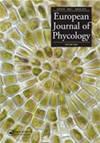西北太平洋Dictyosiphan(Ectocarpales s.l.,Phaeophyceae)的分类学修订,并对D.asiaticus sp.nov.和D.sparsus sp.nov..进行了描述
IF 1.7
4区 生物学
Q2 MARINE & FRESHWATER BIOLOGY
引用次数: 1
摘要
摘要:亚洲Dictyosivon asiaticus sp.nov.和D.sparsus sp.nov..是在日本和西北太平洋地区新发现的。基于线粒体cox1和cox3以及叶绿体atpB、psaA、psbA和rbcL DNA序列的分子系统发育研究表明,Dictyosiphon在全球范围内至少包括7个谱系。日本双虹吸管物种形成了两个高度支持的分支,是一个分支的姐妹,该分支包括来自北太平洋、北极和西北大西洋冷水区的标本。其中一个日本分支(=D.asiaticus sp.nov.)的标本在形态上与D.foeniculaceus(来自英国苏格兰的描述属)相似,具有带细枝的密集分枝的铊,并且附生在Scytop虹吸管属和Chordaria属上,稀疏的分枝,顶端钝,附生于Chordaria spp.我们将分布在北太平洋两侧的第三个分支归属于D.sinicola,该分支是从美国华盛顿描述的,原因如下:该地区的Dictyosiphon标本具有相对密集的分枝细尖铊,已被鉴定为D.foeniculaceus,而D.sinicola与它们的区别在于其明显更大的铊,而在解剖学上它们非常相似。然而,A.foeniculaceus在该地区的分布并不广泛,仅报道了一个遗传谱系(种),因此这两个分类单元被认为是同一物种的生态型,D.sinicola是该分类单元的有效名称。本文章由计算机程序翻译,如有差异,请以英文原文为准。
Taxonomic revision of Dictyosiphon (Ectocarpales s.l., Phaeophyceae) from the north-western Pacific, with descriptions of D. asiaticus sp. nov. and D. sparsus sp. nov
ABSTRACT Dictyosiphon asiaticus sp. nov. and D. sparsus sp. nov. are newly described from Japan and the north-western Pacific. Molecular phylogenies based on the mitochondrial cox1 and cox3 and chloroplast atpB, psaA, psbA and rbcL DNA sequences revealed that Dictyosiphon comprises at least seven lineages worldwide. Japanese Dicytosiphon species formed two clades with high support and were sister to a clade including specimens from the cold-water regions of the northern Pacific, the Arctic, and the north-western Atlantic. Specimens of one of the Japanese clades (= D. asiaticus sp. nov.) were morphologically similar to D. foeniculaceus (generitype described from Scotland, UK), having densely branched thalli with fine branches, and were epiphytic on Scytosiphon spp. and Chordaria spp. Specimens of the other Japanese clade (= D. sparsus sp. nov.) were morphologically similar to D. chordaria, having somewhat thicker, sparse branches with blunt tips, and were epiphytic on Chordaria spp. We assign the third clade distributed on both sides of the North Pacific to D. sinicola, which was described from Washington, USA, for the following reasons: Dictyosiphon specimens in the region having relatively densely branched thalli with fine tips have been identified as D. foeniculaceus, and D. sinicola was distinguished from them by its remarkably larger thallus, while anatomically they are very similar. However, D. foeniculaceus is not widely distributed in the region, with only one genetic lineage (species) reported, so that those two taxa are considered to be ecotypes of the same species, and D. sinicola is the valid name for the taxon.
求助全文
通过发布文献求助,成功后即可免费获取论文全文。
去求助
来源期刊

European Journal of Phycology
生物-海洋与淡水生物学
CiteScore
4.80
自引率
4.20%
发文量
37
审稿时长
>12 weeks
期刊介绍:
The European Journal of Phycology is an important focus for the activities of algal researchers all over the world. The Editors-in-Chief are assisted by an international team of Associate Editors who are experts in the following fields: macroalgal ecology, microalgal ecology, physiology and biochemistry, cell biology, molecular biology, macroalgal and microalgal systematics, applied phycology and biotechnology. The European Journal of Phycology publishes papers on all aspects of algae, including cyanobacteria. Articles may be in the form of primary research papers and reviews of topical subjects.
The journal publishes high quality research and is well cited, with a consistently good Impact Factor.
 求助内容:
求助内容: 应助结果提醒方式:
应助结果提醒方式:


